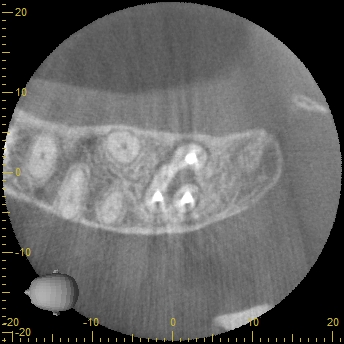CBCT Imagery
Patient presented with pain and swelling on the lower right quadrant. Teeth #'s 30 and 31 were treated around 7 years ago. Periapical radiolucencies are faintly visible around the mesial and distal roots of #30 and also #31. A CBCT image more clearly revealed the extent of the bone loss around the root tips. The post was removed and the root canal was retreated on #30. A large, ribbon shaped distal canal may explain a persistent endodontic infection.
Patient presented with pain and swelling on the upper left quadrant. Tooth #15 was previously treated with root canal therapy. A large periapical radiolucency enveloped all three root tips. CBCT examination revealed a second, untreated canal in the mesial buccal root. This tooth may have been recommended for extraction if a potential source of the infection (missed canal) was not identified by CBCT. Due to this potential source, retreatment was indicated.
Patient presented with a history of spontaneous, throbbing pain on the lower left. Initially the tooth was sensitive to cold, but it had subsided a few days later. Initial clinical exam indicated potential fracture but periapical radiographic evaluation did not add any evidence. CBCT imagery further confirmed the presence of the fracture, along with an isolated vertical bony defect. The tooth was diagnosed with a partially necrotic pulp and crown-root fracture.
Patient presented with spontaneous throbbing pain on the lower right side. Clinical exam produced slight percussion sensitivity on tooth #30. Cold produced no response indicating possible pulpal necrosis. Although the periapical radiographic exam failed to show signs of apical periodontitis, CBCT was able to confirm widened apical PDL space. Upon entering the tooth, an empty, infected pulp space was discovered.
Patient presented with cold sensitivity on the lower left. A periapical radiograph showed a radiolucency superimposed over the pulp chamber. The CBCT clearly showed the radiolucency to be advanced invasive cervical resorption, in which the bone succeeded in perforating into the pulp chamber.

















